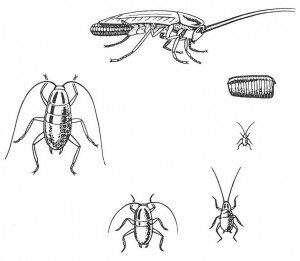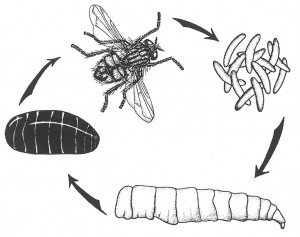
Most insects lay eggs. Some insects like cockroaches and crickets have offspring that looks a lot like the grown insects. However, they do not have wings, their genitals are not yet developed and they often have a different body shape and colour compared to the grown insects. Insects go through a number of development stages and will slowly begin to look like the adult insect. This kind of development is called incomplete metamorphosis.
In other insect groups, we find complete metamorphosis. Complete metamorphosis is seen within flies, beetles and butterflies. The complete metamorphosis goes through several larval phases, which do not have any resemblance to the adult insect.
The development towards maturity takes place in a special phase, the pupa phase that is. When the adult insect comes out of the cocoon it does not grow anymore.
Tiny cockroaches may be cockroaches, which are not yet adults, while small flies flying around, are not the offspring of bigger flies.

Insect development and metamorphosis are controlled by hormones. The hormones are formed in special glands on the lower side of the brain and in the prothorax. The hormones are distributed with the blood. It is a particular moult-inhibiting hormone that starts the moulting. Although it is formed in glands in the prothorax, it has been shown that hormone production in these glands is controlled by a hormone produced by glands in the brain. Besides these two hormones, the so-called juvenile hormone has a crucial role in moulting. It is secreted by a pendant on the brain and it is the amount of juvenile hormone in the blood that determines what phase a larva enters the next time it sheds its skin.
In young larvae, the juvenile hormone is present in large quantities, but hormone production decreases as the larvae grow older and when the hormone is below a certain value, the larvae begin to go into the pupal stage.
Knowledge of these processes is of great practical value. Synthetic-made insect hormones may in some cases be used in pest control without being dangerous to humans. Sprayed on insect habitats or in tiny amounts mixed in baits, synthetic hormones may mess up the vital processes so that insect development is impaired or the insects simply die.




